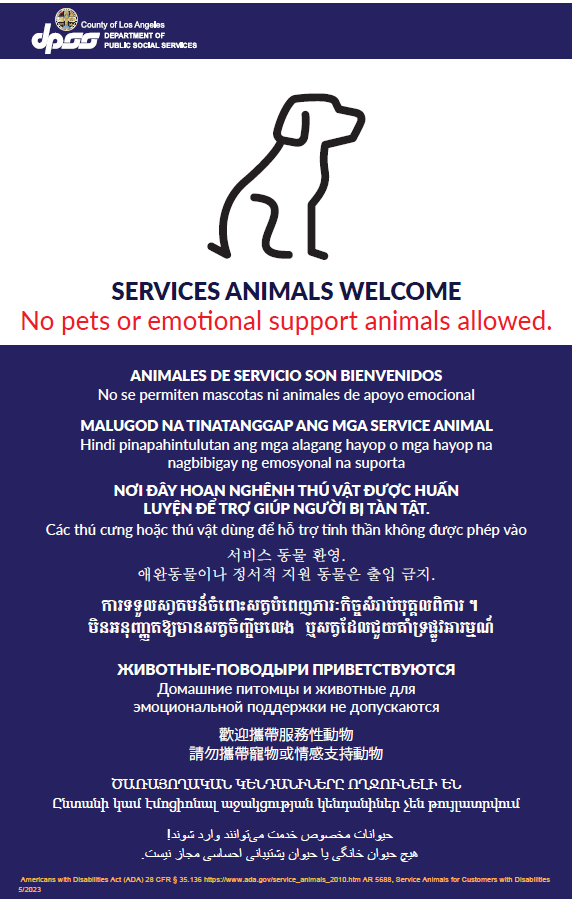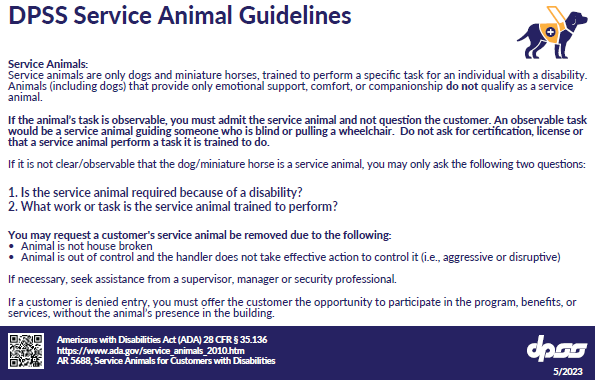CIVIL RIGHTS
- Main
- Index
- Glossary
- Filters
Service Animals for Customers with Disabilities
Section Heading
Purpose
To revise an existing policy and/or form(s).
What changed?
- New Service Animal Poster (Attachment I) and instructions are added to this release.
- New DPSS Service Animal Guidelines (Attachment II) and instructions are added to this release.
Policy
The Department of Public Social Services (DPSS) is committed to providing excellent customer service and does not discriminate against qualified individuals with disabilities. DPSS complies with the Americans with Disabilities Act (ADA) Title II, Service Animal provisions that requires all local entities, including DPSS and its contracted offices to modify policies and practices to permit the use of a service animal by a person with a disability in public access areas.
All DPSS staff and contract staff, including security personnel, must allow customers with disabilities and their service animal entry to all public access areas in DPSS offices. Public access areas include:
- Lobbies
- Interview areas
- Reception areas
- Restrooms
To ensure the safety of all customers and staff, only qualified service animals are permitted in DPSS public access areas. Animals, including dogs, that provide only emotional support, comfort, or companionship do not qualify as service animals and will not be permitted to enter DPSS offices.
Service Animal Poster and Service Animal Guidelines Reference Card
All DPSS public facing offices shall display the Service Animal Poster (Attachment I) in a visible area at the building’s entry. The poster includes all DPSS threshold languages.
The Service Animal Poster and DPSS Service Animal Guidelines reference card (Attachments I and II) are requested as follows:
Impact
CalWORKs, CalFresh, CAPI, Child Care, GAIN, Medi-Cal, District Operations, General Relief, IHSS, and START
Available Through
WLAMS
Ordering Instructions
Order supplies from WLAMS via a PA 16, Supply Requisition. An initial supply of the Service Animal Poster and Service Animal Reference Card will be distributed in all threshold languages to all DPSS offices. Additional supplies must be requested by each DPSS office through WLAMS.
Background
Under the ADA Title II, State and local governments, businesses, and non-profit organizations that serve the public must allow service animals to accompany persons with disabilities in all areas of the facility where the public is normally allowed to go. Furthermore, persons with disabilities who use service animals must not be subjected to different processes or procedures than persons without a disability.
Definitions
Service Animal
Dogs of any breed, or miniature horses, that are individually trained to do work and/or perform tasks for people with disabilities. The work or task a service animal is trained to provide must be directly related to the person’s disability. Service animals are working animals, not pets. Examples of such work or tasks include, but are not limited to:
- Guiding people who are blind;
- Alerting people who are deaf;
- Pulling a wheelchair;
- Alerting and protecting a person who is having a seizure;
- Reminding a person with mental illness to take prescribed medications; and
- Calming a person with Post Traumatic Stress Disorder (PTSD) during an anxiety attack or performing other duties.
Additional examples are provided in the Examples section of this release.
Note: In addition to existing provisions regarding service animals, ADA regulations have a separate provision for miniature horses that are individually trained to do work or perform tasks for people with disabilities. Miniature horses generally range from 24 to 34 inches in height and weigh between 70 to 100 pounds. Entities covered by the ADA must modify their policies to permit miniature horses where reasonable.
Pets
Any domesticated animals kept for pleasure rather than utility are not considered service animals under the ADA.
Emotional Support Animals
Any animal that provides comfort to a person with a disability, but is not trained to perform specific tasks to assist them with their disability. The provision of emotional support, well-being or comfort is not the type of “work or tasks” considered in the ADA’s definition of a service animal.
Housebroken
Animal that has been trained to urinate or defecate outside the home or in an acceptable place indoors/outdoors.
Requirements
The owner and/or handler of the service animal is responsible for the following:
Harness: Ensure the service animal is harnessed, leashed, or tethered, unless these devices interfere with the service animal’s work. In that case, the customer must maintain control of the animal through voice, signal, or other effective controls.
Proximity of the Animal: Ensure the service animal always remains 24 inches in proximity of the owner/handler unless the nature of a trained task requires it to be working at a greater distance.
Care and Supervision: Providing care and supervision for the service animal, including food, water and cleaning up after the service animal.
Note: Service animals do not require a vest, harness, or certification that identifies them as a service animal.
Verification Docs
N/A

